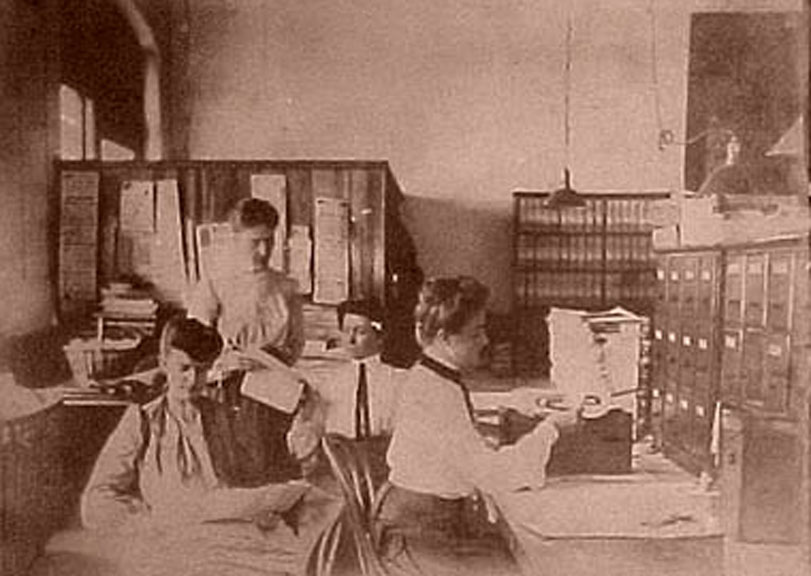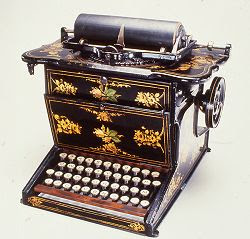The previous post (Careers for Girls) set the scene, so to speak, about girls’ education and the careers that might – or mostly didn’t – follow their time at school. This one looks at some details.
The dominant ideology of public/private spheres meant that girls’ education was imbued with the idea of them not seeking to have ‘professional’ roles but to undertake employment until they married. In other words, their occupations were seen as a stopgap until they acquired a husband who would provide them with a home and income. Consequently any choosing of employment would not be done in the same way as school leavers of today who select a career with a view to continuing with this whether married or not. It is an indication of the way society has changed beyond the recognition of the C18th or even the C19th Miss.
In a sectional study of approximately 650 RMIG pupils between 1851 and 1908, representative rather than comprehensive, the two biggest categories of employment were clerical and teaching. How much stems from being pushed in those directions by the School (‘Do you want to be a secretary or a teacher?’) or those sorts of posts being more readily available is an unanswerable question without a deal of close and detailed research into individuals. And as many of those individuals are no longer walking the earth, it somewhat hampers the investigation. Refuge in generalities it is then. Nursing, surprisingly, came a very unclose third in the tables with only 4% of the survey going into the caring profession. However, given the date range of the survey sample, it is possible that these results reflect the fact that nursing had been perceived as a working class occupation. Later, more rigorous organised training opened it to a higher class of women and had the survey sampled a slightly later time period, the percentage opting for nursing may have been higher.

In a book by Mercy Grogan entitled How Women may earn a living published in 1880, the following careers were described as ‘suitable’ employment for women:
teaching generally and tutoring in music and cookery; artistic activities such as china painting and art needlework; clerk based roles in the Post office and law copying, telegraphy and bookkeeping; printing; shop assistant work in linen draperies; becoming a school board visitor; the role of superintendent in laundries; concertina making; and hairdressing.
Most of these are self-explanatory although some have ceased to exist. Law copying related to days before it was possible to make multiple copies of documents at the press of a button. People were employed to copy out documents laboriously by hand.

As for a school board visitor – this is an interesting choice to be described as suitable for a woman to carry out. ‘The School Board Visitors perform amongst them a house-to-house visitation’ wrote Charles Booth in Life and Labour of the People in London, their purpose being to ensure that children who should be in school were in attendance. Until universal education was made free, there was a cost imperative in sending children to school (known as ‘the school penny’), something impoverished families often found difficult, especially compared with the additional money a child could earn from not being in school. A Visitor must have encountered opposition from time to time and possibly even threats of violence as they sought to ensure school attendance, it possibly being seen as ‘interference from do-gooders’.
The reference to concertina making may cause amusement. Was it really such a widespread industry that it was included in a list of suitable professions? And why was it deemed suitable for women? One can only imagine the smaller, and possibly more dextrous, fingers of a woman might be preferred to the strength of a male.
In the same year (1880), Phillis Browne produced a book with a chapter entitled ‘Work for Necessity’.[i] This implied that whilst employment was not the desirable option, some choice was possible, albeit from a rather limited range. Teaching was regarded as the main female occupation. Twenty years later a publication by Helen Candee (How women may earn a living) contained twenty-two chapters of suitable employment categories including nursing and teaching, care of hair, flowers and typewriting but also architecture and interiors, hack writing and advertising, from which it may be deduced that, in the subsequent twenty years, many more professions had become suitable.
A hack writer, for those less familiar with term (i.e. most of us), is ‘a writer who is paid to write low-quality, rushed articles or books “to order”, often with a short deadline’ (Wikipedia). Also known as a pen for hire, the phrase arose from ‘hackney’ which was a hired horse. It is synonymous with low paid work thus implying that it was suitable for women as they were only biding time until Mr Right came along. ‘Many authors who would later become famous worked as low-paid hack writers early in their careers’ (ibid). These include Anton Chekhov, Arthur Koestler, Samuel Beckett and William Faulkner. Note the absence of female names in this reference!
Clerical work, originally a profession for men, changed when technology, such as the typewriter, was introduced: ‘the work became both more monotonous and at the same time […] offered fewer chances for advancement. As these occupations took on a proletarian character, females began to enter them in significant numbers.’[ii]

By and large schools were very conservative in outlook and RMIG was no exception. The primary choice was employment or marriage: ‘girls still learned that careers for women had to be bought at the high personal cost of remaining celibate.’[iii] In fact until the mid C20th, women were expected to give up paid employment upon marriage. Known as the Marriage Bar this ‘required single women to resign from their job upon getting married and disqualified married women from applying for vacancies. They were in common use up until the 1970s’ https://www.ictu.ie/blog/marriage-bar-ban-employing-married-women
That women’s careers were seen as secondary to men was amply demonstrated when women took on men’s roles in WWI, made a very competent fist of them but, nevertheless, were out of work the moment the men came back from fighting. And, of course, this links with the great battle to get the vote – finally granted in 1918 to ‘enfranchised women over the age of 30 who were either a member or married to a member of the Local Government Register.’[iv] This compares unfavourably with New Zealand where women had been able to vote after 1893. It was 1928 before women had the same rights to vote as men in UK.
However let us not get sidetracked by female suffrage. (The soap box got a bit excited but is now disappointed.)

Back to the careers advice offered to RMIG pupils. As with any generalisation, there are always exceptions and amongst the many teachers, clerical roles and nurses in the study, there was also a missionary, a gardener, a dispenser, an artist, an author and a typecutter – in each case a single example. There were a lot more shop assistants and those working in domestic service although most of these followed the unwritten rule of being stopgap occupations. Only 2% of the sample stayed in domestic service and did not marry and one has the feeling that the latter was the reason for the former rather than domestic service being perceived as a career.
Of course, if we jump forward in time to 1988 – the bicentenary year of the School – and have a quick look at those leaving from the 6th form, we have a whole raft of different potentials. Some may sound more similar (art history, modern languages, geography, history, teaching, nursing, mathematics) although with modern twists. Some have developed a long way from the nineteenth century occupations but have the same roots: pharmacy, business/marketing, physiotherapy, civil engineering (for men anyway. It was not regarded as an occupation for women until much later). Others reflect the way the world has developed: computer science, travel & tourism, radiography, criminology & forensics. What is clear though is that there is no longer any question of it being either career or marriage and nor are there as many clear cut divisions between male and female occupations.
This more specific look at the kind of occupations of RMIG/RMSG former pupils does not show the School to be unique in its approach – then or now. It is society that has changed and continues to change but today’s pupils can be thankful they have a very much wider range of opportunities than their Victorian counterparts.
[i] Browne, Phillis, [pseud. Sarah Sharp Hamer. 1839-1927] What Girls can Do: a book for mothers and daughters
[ii] Gorham, Deborah, The Victorian Girls and the Feminine Ideal
[iii] Dyhouse, Carol, Girls growing up in late Victorian & Edwardian England, 1981
[iv] Fawcett, Millicent Garrett. The Women’s Victory – and After.

